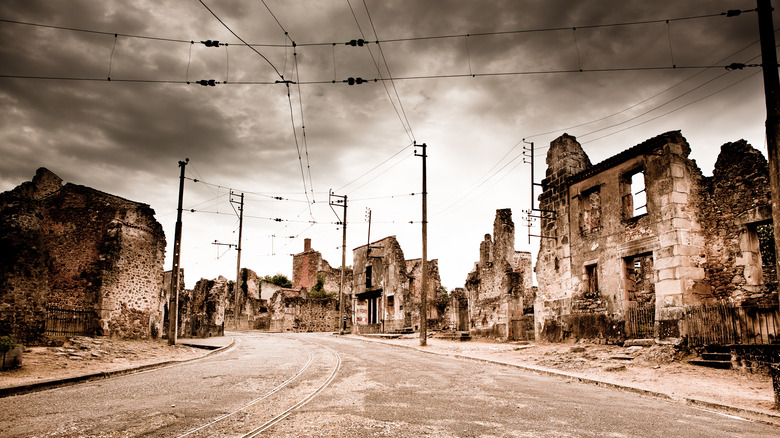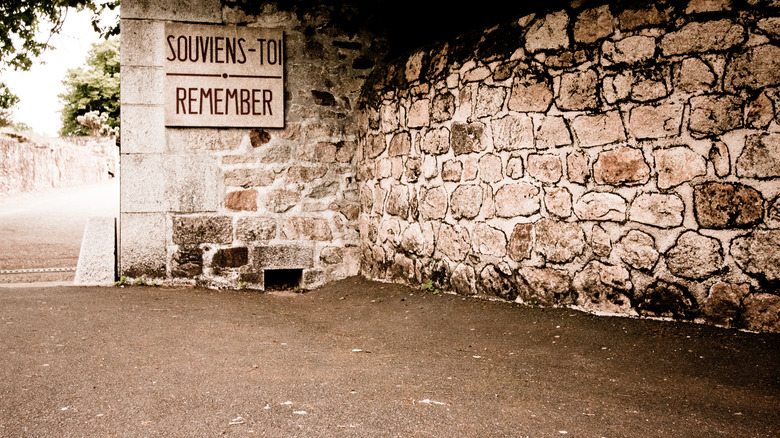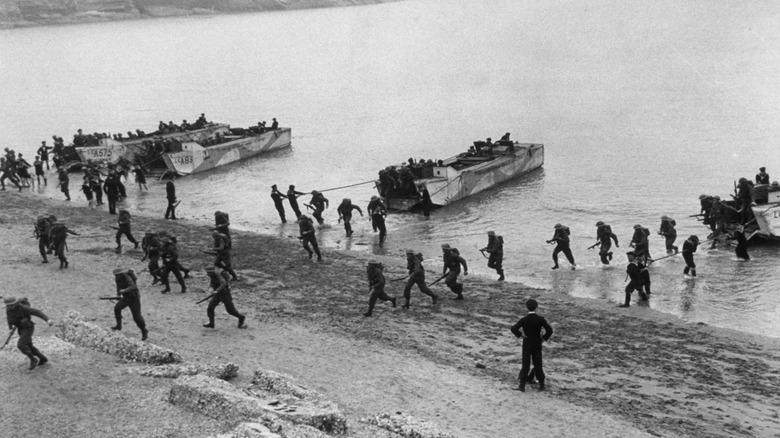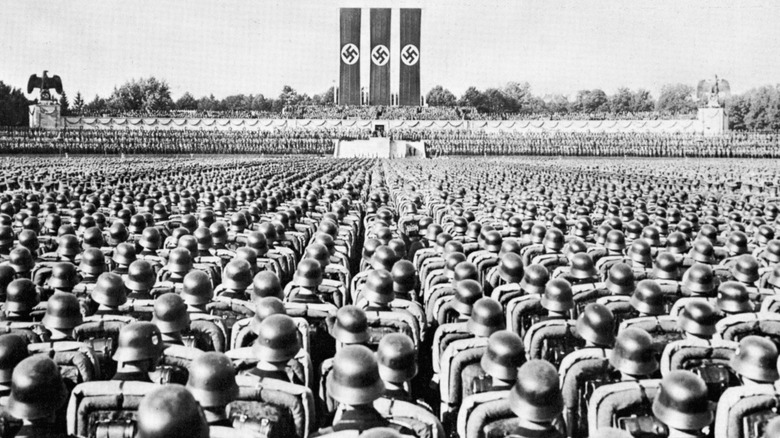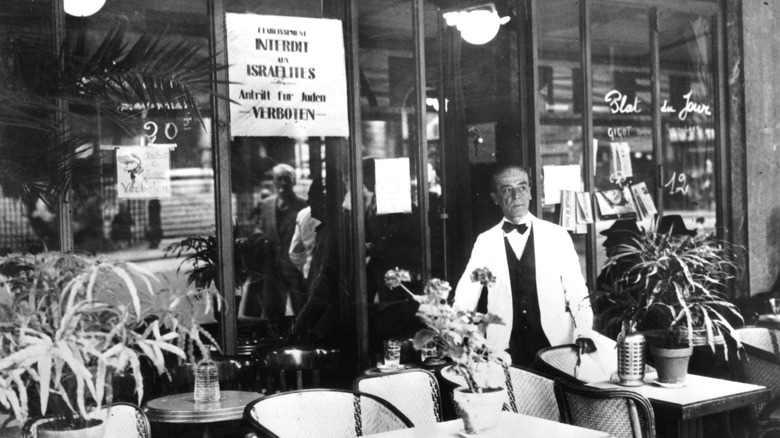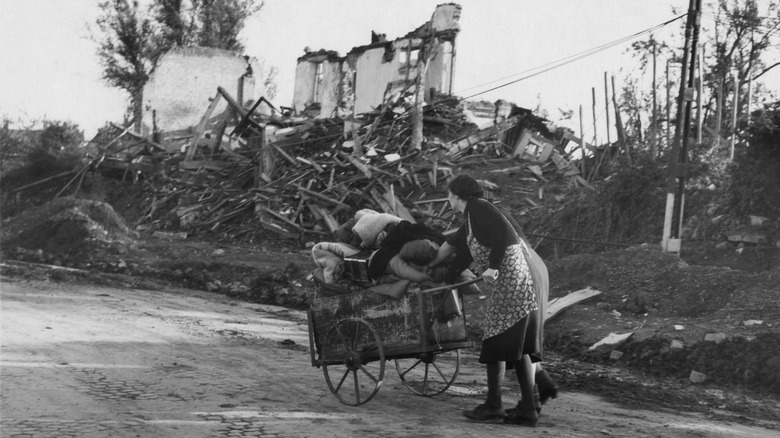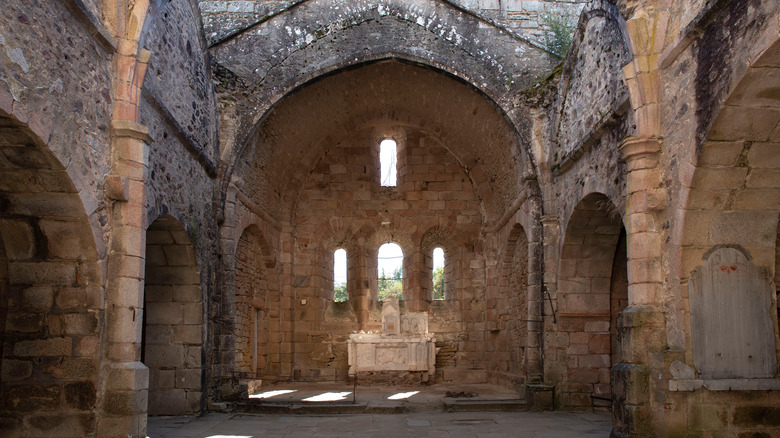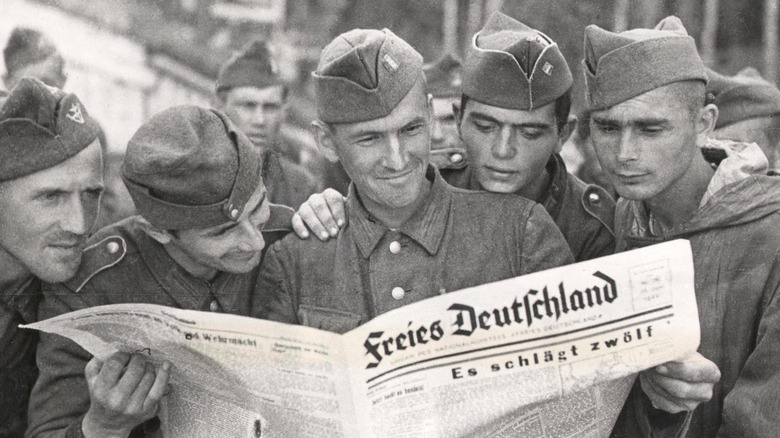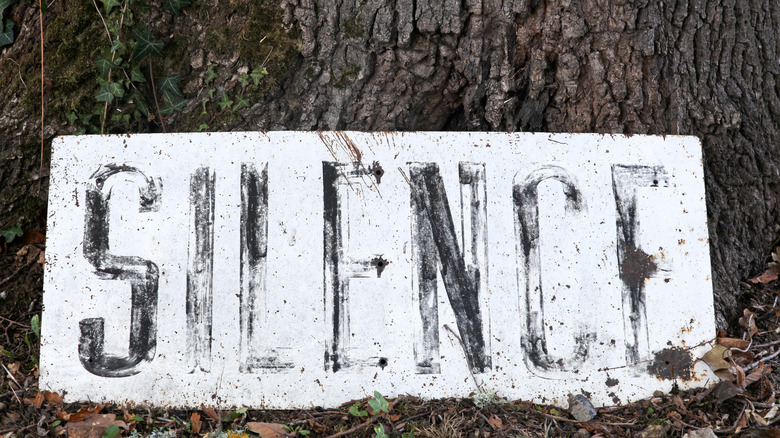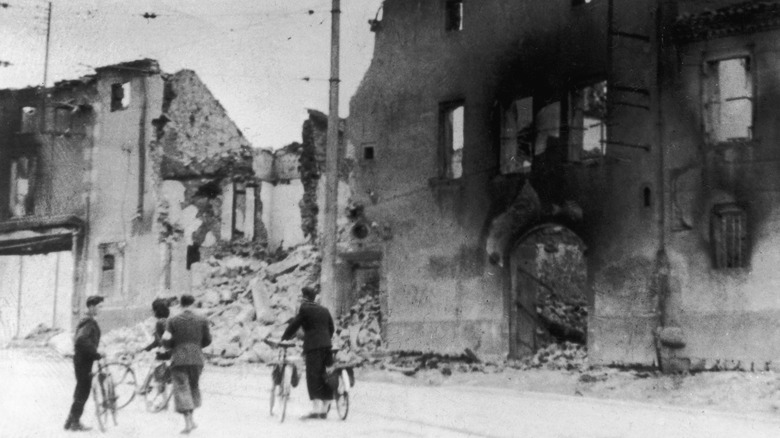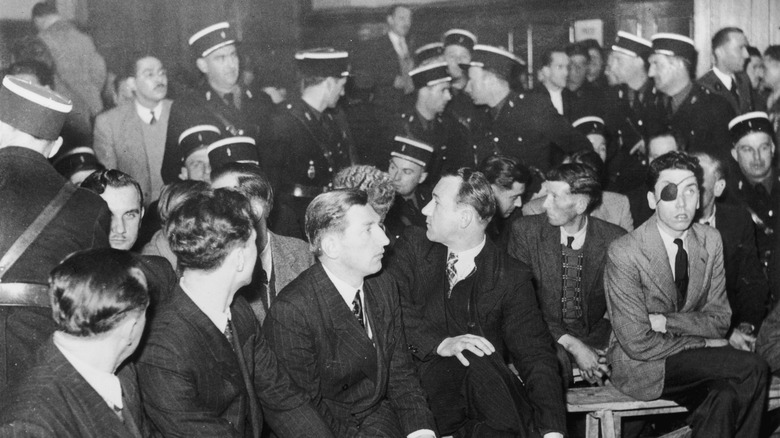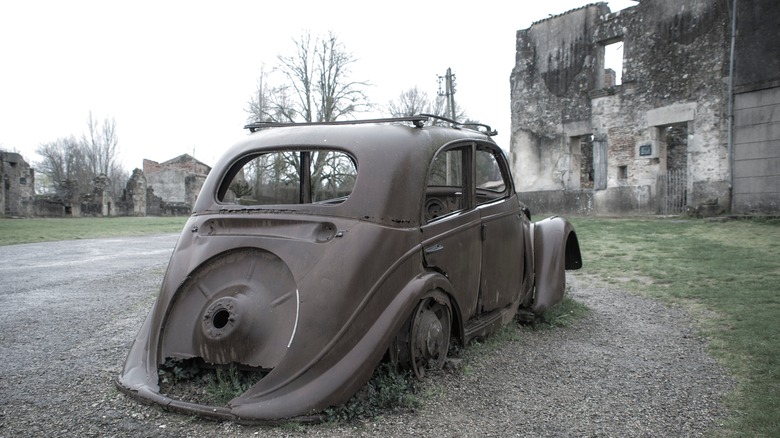The Messed Up Truth About The French Town Nazis Torched
A visit to the martyred French village of Oradour-sur-Glane is both moving and horrifying (via the National WWII Museum). With its shattered structures and fire-blackened buildings, the hollowed-out city represents an undeniable reminder of Nazi terrorism in German-occupied France. The memorial bears witness to the swift, indiscriminate nature of SS violence meted against civilians.
According to Smithsonian Magazine, the martyrdom of Oradour-sur-Glane brought a familiar Nazi tactic from the Eastern to the Western Front, one that had terrorized residents of the USSR since at least 1941. It started with an order from Wilhelm Keitel, head of Nazi High Command: "Since we cannot watch everybody, we need to rule by fear," as quoted in Per Anders Rudling's "Schooling in Murder: Schutzmannschaft Battalion 201 and Hauptmann Roman Shukhevych in Belarus 1942." In one push to secure Russia, German forces razed 629 villages in Belarus and burned down an additional 5,454. Another infamous example involved the total annihilation of the Czech town Lidice in June 1942, per the Holocaust Encyclopedia.
Such attacks marked reprisals for perceived civilian resistance. But they also paved the way for the colonization and re-population of Russia with German residents. When it comes to Oradour-sur-Glane, though, unanswered questions abound, including what made the SS hone in on this unlikely location in the first place. Nevertheless, the SS acted with frightening rapidity, completing its atrocities in a sole afternoon. Here's the messed up truth about the French village razed by the Nazis.
The attack took place in Nazi-occupied France
A humble farming village with less than 1,000 residents, Oradour-sur-Glane sat 15 miles from Limoges in southwest France (via Holocaust Encyclopedia). Considered exemplary of small-town France, it remained shielded from many of the horrific events that rocked the French countryside during the war years. But in 1944, everything changed.
In one of the most brutal attacks against civilians on the Western Front, German forces invaded the town, slaughtering its residents and razing the city with shocking and practiced precision. Within a couple of hours, between 160 and 200 Waffen SS 2nd Panzer Division troops (per The Irish Times) slaughtered 648 inhabitants, nearly the whole population (via Oxford). This number included 207 children (with six infants less than six months old), 245 women, and 196 men. To enhance the psychological devastation of the attack, they burned most of the villagers alive, machine gunning down those who dared to flee.
Survivors proved shockingly few, including one woman who survived falling from a church window, breaking her leg, and getting shot. She lost her entire family in the events of that day, including her son, two daughters, husband, and infant grandson. Six men also managed to escape despite getting shot. Apart from these eyewitnesses, approximately 15 other individuals hid from the Germans, avoiding the roundup before the massacre.
It happened on the precipice of renewed hope for French liberation
The Allies landed at Normandy on June 6, 1944, and the French Resistance intensified its efforts to inflict damage on German military installations, per the Holocaust Encyclopedia. In the weeks leading up to D-Day, the French Resistance received hints of an impending intervention, but the Allies kept details vague, per War History Online. However, they did encourage Resistance fighters to participate in various ground actions supporting the invasion.
French Resistance fighters sabotaged France's railway system and the road network. They destroyed phone and power lines and attacked command posts, enemy fuel depots, and ammunition dumps. Some of these efforts proved wildly successful. The Resistance took out 1,500 locomotives and 577 railroads, 75 percent of France's northern railway system. With the help of British warplanes, they destroyed between 18 and 24 bridges and rendered 30 roads impassable.
As the French countryside exploded with anti-German partisan activity, Nazi forces faced strategic sabotage at every turn. Success at Normandy only cemented this realization, leading the SS to new lows. It's no coincidence that the martyrdom of Oradour-sur-Glane took place on June 10th, just as hope for French liberation looked brighter than ever before. Yet, Germany's official surrender wouldn't come for another year (via National Geographic), with indiscriminate destruction characterizing those 12 months.
The destruction to crush the Resistance
The successful invasion of Europe from the beaches of Normandy left German forces in disarray and desperation, as reported by the Holocaust Encyclopedia. Cornered by the Allies and hampered by the French Resistance, German forces struck out like cornered animals. They also operated within the so-called "fog of war," necessitating lightning-fast decisions despite poor awareness of the ground situation. Desperation led the Nazis to increasingly brutal measures, putting down potential local resistance with maximum blood loss, as discussed in Carl von Clausewitz's "On War" (Section 3).
Field Marshal Gerd von Rundstedt exemplified the danger inherent with cornered German forces when he called for total war in Southern France. Demanding the subjugation of local populations with ruthless calculation and speed, he declared the "expectation that the major operation against the gangs [i.e., partisans] in Southern France will be carried out with the greatest severity and without leniency."
The German military commander in France, General Karl-Heinrich von Stülpnagel, rushed to fulfill these orders through the redeployment of units from occupied France northward. He ordered them to Normandy, hoping to reinforce the Nazi stranglehold on Europe. Among these groups was Das Reich, the 2nd Waffen-SS Panzer Division (via Oxford). A unit relocated to Montauban, France, in January 1944, Das Reich boasted two years of action on the Eastern Front, which primed it for the brutal attack on Oradour-sur-Glane.
Nazi-occupied France was at the mercy of Das Reich
General Heinz Lammerding commanded the 2nd Waffen-SS Panzer Division Das Reich, which had executed brutal anti-partisan activities in Eastern Europe, per the Holocaust Encyclopedia. Tens of thousands of innocent civilians died in actions across Eastern Europe, Russia, and Greece. But France remained unfamiliar with total war until June 1944. That's when residents of Tulle and Oradour-sur-Glane learned firsthand what it meant to live (and die) at the mercy of Das Reich.
It started with the June 9th hanging of 99 men in the village of Tulle near Limoges. The massacre represented an anti-partisan retaliation for the June 7th seizure of Tulle by the Resistance, as reported by Open Democracy. Coupled with the lynchings, came the removal of 149 individuals to Dachau (via UPI). Of the 149 deported to the infamous concentration camp, 101 vanished. Yet, the massacre at Tulle represented child's play for Das Reich. The unit's commander had a much bigger target in his sight, and German-occupied France could do little to stop him.
Following the 1940 German invasion of France, Nazis had disarmed the public, relying on pre-war French firearm registration records, per Stephen P. Halbrook's "Gun Control in Nazi-Occupied France: Tyranny and Resistance." Many French citizens who refused to comply with these gun control measures had already faced firing squads. While pockets of armed rebellion existed, locals in places like Oradour-sur-Glane remained sitting ducks, unable to fight back.
Oradour-sur-Glane had doubled in size due to refugees
Oradour-sur-Glane's pre-war population hovered around 350 (per the Holocaust Encyclopedia). But by 1944, the town swelled with refugees, including Jews and Alsatians, according to The History Press. A handful of refugees from Francoist Spain also lived there (via The Irish Times). Nearly 700 residents called the rural village home. Some, like a Jewish girl named Sarah Jackobowicz, had arrived in Oradour just days before Das Reich's hellish visit.
These refugees enjoyed the safety and peace the city provided. It had seen little action from the Resistance or the German military (via Helen Watts' "One Day in Oradour"). The town even included a refugee school. Residents of Oradour-sur-Glane prized their idyllic town, which represented a last bastion of stability in a sea of chaos. It was the last place on Earth anyone would've expected a municipal massacre to unfold.
The Jewish refugees living in the city had enjoyed an uncharacteristic degree of safety and freedom in the months leading up to the massacre, as detailed by Helen Watts. Unlike other parts of France and Europe, they lived without fear of renunciation. Yet, they remained acutely aware of their unique situation and the horrors facing Jews in other parts of Europe. When the SS Panzer Division arrived on that June day, demanding that the town assemble in the square, refugees proved the most likely to hide for fear of concentration camp deportation. A lucky few escaped.
They rounded up residents and burned them alive
After arriving in Oradour-sur-Glane, the 3rd Company, 1st Battalion, 4th SS-Panzergrenadier Regiment Der Führer, a subordinate of the 2nd SS Panzer Division, summoned residents into the town square (via Oxford). They divided the residents by age and gender, imprisoning 245 women and 207 children and infants in the village church, according to the Holocaust Encyclopedia. They dispersed 197 men between six locations, including barns. Next, the machine guns came out.
One survivor testified that the SS fired at the men's legs, rendering escape impossible. Then, the Germans doused them in fuel and set them on fire. Inside the church, where the women and children remained locked up, the SS detonated an incendiary containing asphyxiating gas. A shower of machine gun bullets tore down escapees as soldiers threw additional grenades inside. Lieutenant Raymond Murphy, an American shot down over France, saw the village afterward, noting, "About three weeks ago, I saw a town within four hours bicycle ride up the Gerbeau farm where some 500 men, women, and children had been murdered by the Germans. I saw one baby who had been crucified" (per Foreign Policy).
The Waffen SS extermination effort proved terrifyingly swift and successful. Of the seven survivors, all were severely wounded. Oradour-sur-Glane went down as one of the worst attacks on civilians in German-occupied France. Unfortunately, the tragic efficiency of the Nazi killing machine meant so few survived that the events of the day remain murky.
Fighting with the Waffen SS were Frenchmen from Alsace
One of the most shocking realizations to come from the vicious destruction of Oradour-sur-Glane was the involvement of fellow Frenchmen in the atrocities, according to The Irish Times. All told, 14 men served in the Waffen SS from Alsace-Lorraine, a German-speaking region of Eastern France, annexed into Nazi Germany near the war's start. These Alsatians participated in massacring their former countrymen and women.
Yet, 13 of the Alsatians claimed they had no choice, drafted into the German military against their will. As for the 14th Alsatian, he admitted volunteering to serve with the Panzer Division. After the war ended, these admissions received consideration when doling out fitting punishments. For example, the man who volunteered to join the SS unit received the death penalty. But his comrades faced milder fates. According to Oxford, five received jail terms, and nine got sentenced to forced labor. Their sentences varied from five to 12 years.
But some within the French government felt that the Alsatians had faced an exceptional experience that required greater leniency. On February 19, 1953, the French Parliament passed a measure granting the Alsatian prisoners and former Waffen SS members amnesty. The Alsatians forced to serve with the Nazis in Oradour-sur-Glane walked away scot-free.
Nobody knows what motivated the attack
Nobody knows for sure why Oradour-sur-Glane suffered the full brunt of the Nazi civilian killing machine, as reported by The Irish Times. After all, the town had no tangible ties to the Resistance, unlike neighboring cities like Limoges and regions like Dordogne. But after World War II, the village got elevated to near-mythic status, making the ultimate motivation less critically examined.
Various theories have been put forth, but one hypothesis stands out from the rest because of its icy calculation. With its population of less than 1,000, Oradour-sur-Glane represented the perfect destination for a quick and easy one-day massacre. But other scholars claim it had more to do with the village's affluence, marking it as a prime target for plundering. After all, the town remained largely untouched by World War II.
Oxford argues that we must see the city's massacre within the larger context of the German military's evolution during World War II. Instead of occurring in a vacuum as an arbitrary act, "it fitted into a pattern of actions against civilians ... characteristic of the violence of Nazi occupying troops, perhaps more common on the Eastern Front but increasingly transposed to the Western fringes of Europe as well." Whether an act of retaliation or an instrument in the regional subjugation toolkit, the events at Oradour sent shockwaves through Europe.
Excuses for the martyrdom of the village
Without survivors of the horrors of Oradour-sur-Glane, the Waffen SS could have woven a narrative more favorable to the unit (via the Holocaust Encyclopedia). And this is precisely what German officials attempted to do in the days and weeks following June 10th. Major Adolf Diekmann, commander of the Waffen SS troops, fabricated a story that he ordered all officers, commissioned and non-commissioned, to tell.
According to Diekmann's story, the men of Oradour-sur-Glane allegedly attacked the Waffen SS while in the village. A fight ensued, resulting in the deaths of nearly every man in town. During the gunfight, the women and children hid in the church. But an explosion from a nearby ammunition supply dump resulted in a blast contributing to their deaths due to smoke inhalation. Of course, this didn't explain why the vast majority of bodies were unrecognizable due to fire damage.
Despite the official narrative, public outcry intensified. Fearing the Vichy government in France might use this opportunity to switch sides and work with the Allies, the Nazi Army Commander-in-Chief in Western Europe launched a faux investigation. By January 1945, the inquiry yielded unsurprising results. Officials clung steadfastly to the tale woven by Diekmann, claiming "Military concerns justified the retaliation."
Justice has proven painfully slow for the victims
Justice has proven painfully slow for the villagers of Oradour-sur-Glane (via Foreign Policy). A 1954 tribunal in Bordeaux came to an abrupt halt after the East German government refused to turn over six German soldiers for prosecution. And General Heinz Lammerding, the man who ordered the massacres at Tulle and Oradour-sur-Glane, never faced justice as Germany refused to extradite him.
Of the 150 to 200 men who participated, just 20 soldiers got tried and convicted of war crimes, according to Open Democracy. Eventually, all got released. The longest serving of these individuals did 14 years, going on to enjoy a decade of life as a free agent. In Helen Watts' "One Day in Oradour," she writes, "For now, the men who killed so many innocent men, women, and children at Oradour-sur-Glane may have escaped punishment, but their actions — and the lessons learned from them — will never be forgotten."
In January 2014, the most recent attempt at justice for the victims of Oradour-sur-Glane began. It involved former German soldier Werner Christukat, 19 years old when his unit destroyed the town. Officials in Germany charged Christukat with aiding in the deaths of 25, either by blockading certain areas or transporting flammable materials to the church. But in a shocking turn of events, the German court thew out the case against Christukat, 89, in December 2014 due to a lack of evidence, per The Journal.
Oradour-sur-Glane remains the sole witness to tragedy
Following the razing of the city, French officials left Oradour-sur-Glane exactly as the Waffen SS had (via Tourism Teacher). Today, the torched buildings, crumbling walls, and cut tram lines attest to the atrocities of June 10, 1944. And the sewing machines, baby prams, mattress springs, and automobiles bear witness to patterns of daily life, frozen in tragedy.
Even the mayor's car sits motionless in the middle of the main street, right where he left it. A closer examination of the ruins also reveals bullet holes and black marks where fire and smoke licked the brick walls of razed buildings. Oradour-sur-Glane has come to represent more than a memorial to the nearly 700 people who died there. The National WWII Museum argues it encapsulates towns across occupied Europe that suffered similar fates.
The 40 acres comprising the site remain a fitting and powerful testament to those who lost their lives on that fateful day, and a visit to the park forces visitors to confront a painful past. Following a call from President Charles de Gaulle, France's National Assembly made the site a historic monument in 1946, per The Irish Times. Today, the Ministry of Culture maintains the ruins. Approximately 300,000 people visit the location annually to take in "an image of France which has been ravaged." It's a potent reminder of a near-distant past that many in Europe would prefer not to acknowledge today, but must never forget (via Open Democracy).
